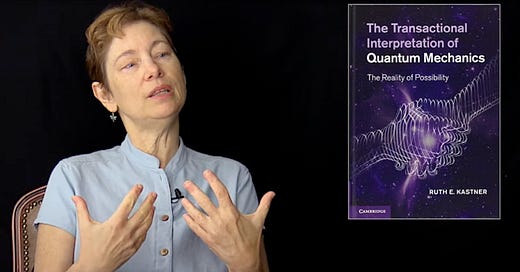Ruth Kastner and I first met several years ago in the context of a seminar series focused on plasma physicist and philosopher Timothy Eastman’s work. Ruth also participated in the “Metaphysics and the Matter With Things: Thinking With Iain McGilchrist” conference I co-hosted at CIIS last March. We’ve been meaning to sit down to see what bridges might be built between her Possibilist Transactional Interpretation of quantum physics (more recently extended into relativity theory) and Whitehead’s process-relational metaphysics. This was the first of what I am sure will be many more conversations.
Ruth and I discuss my paper on eternal objects—"Standing Firm in the Flux: On Whitehead's Eternal Objects"—which is soon to be published in Whitehead at Harvard, 1925-1927 ed. by Joseph Petek and Brian Henning (Edinburgh University Press). You can read a copy here.
I began by recounting my recent discussions with Michael Levin—a biologist exploring what he terms “Platonic morphospace.” I think Levin’s work, which challenges the reductionist confines of actualist materialism in biology by emphasizing a field of possibilities that shapes morphogenesis and regeneration, resonates across disciplines with what Ruth is up to in quantum physics. I suggested that possibility might serve as a kind of formal cause—one that has been overlooked not only in biology but also in quantum physics. I futher suggested that the tension between unitarity and non-unitarity in interpretations of quantum physics mirrors Whitehead’s idea of a continuous realm of possibilities giving way to the discrete actuality of events.
Ruth and I then delved into Whitehead’s philosophy. I explained my fascination with his concept of eternal objects and the notion of concrescence—the process by which a continuum of possibilities irreversibly collapses into a discrete actual occasion. I expressed discomfort with how Whitehead sometimes appears to overly-reify eternal objects, while I prefer to lean on his alternative affirmation of the way eternal objects are dynamically enriched when the “shadow of truth” is cast back upon them by actualized events. Ruth agreed that the exchange between the limitless realm of possibility and the sharply defined realm of actualization is fundamental, and she drew clear parallels between this process and the measurement problem in quantum physics, where unitarity gives way to the collapse of the wave function.
Our discussion shifted to the broader cultural and institutional resistance in physics to the transactional interpretation (TI). Ruth pointed out—and I concurred—that critics often dismiss alternative theories by demanding a novel, falsifiable predictions, even though similar standards would challenge well-established ideas like the kinetic theory of gases or the Higgs mechanism. We both lamented how entrenched actualist paradigms lead to a kind of intellectual double standard, one that refuses to address anomalies such as the inability of conventional quantum theory to account for definite measurement outcomes.
Ruth suggested that our experience of being embodied in space-time might be nothing more than a user interface—an illusion overlaying a deeper, more intricate network of events. I echoed this sentiment by referencing Whitehead’s view that events, or “actual occasions,” are not mere points in space-time but processes that weave or “stitch” together the fabric of reality. In Whitehead’s scheme, every actual occasion synthesizes both a physical pole, anchored in the already determined past (or what—from the perspective of the presently concrescing occasion—he calls “real potentiality”), and a mental pole, tapping into a broader field of “pure” (or at least purer) potentiality. Ruth saw some parallels to TI, where the offer-wave may be akin to the real potentiality inherited by the physical pole, while the confirmation wave is akin to the pure potentiality tapped by the mental pole.
We also explored the semiotic function of eternal objects, considering whether they might be seen as signs mediating between our perceptual experience and the external physical world. We linked Whitehead’s idea of the extensive continuum—a field of potentiality structured by rules of extensive connection—to conservation laws. Ruth suggested that, at least in the context of TI, these eternal rules might condition the flow of energy without fully determining the outcome of any given event, much as conservation laws constrain but do not dictate individual measurement results.
Video of our dialogue:













Share this post